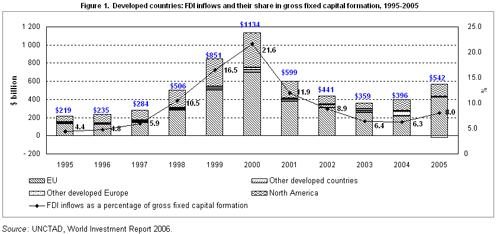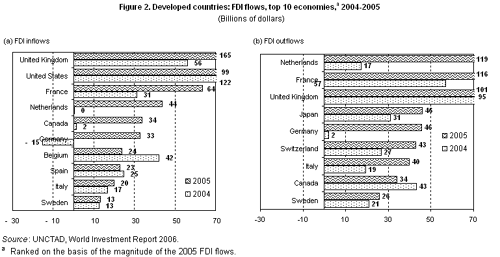| EMBARGO The contents of this press release and the related Report must not be quoted or summarized in the print, broadcast or electronic media before 16 October 2006, 17:00 GMT (1 PM New York, 19:00 Geneva, 22:30 Delhi, 02:00 - 17 October Tokyo) |
Foreign direct investment (FDI) inflows to developed countries jumped 37% to US$542 billion in 2005 (figure 1) and prospects for further increases are promising, says UNCTAD´s World Investment Report 2006, FDI from Developing and Transition Economies: Implications for Development (1) . The increase was partly driven by strong economic growth in some countries and by high corporate profitability, which increased the number and volume of cross-border mergers and acquisitions (M&As) to the second largest recorded since 1987. The surge in M&A activity, spurred by increased support from collective investment funds -- mainly private equity -- included a number of large deals valued at more than US$1 billion, particularly in the services sector.
In 2005, the largest single recipient of inward FDI flows was the United Kingdom ($165 billion) largely due to the merger of Shell Transport and Trading Company and Royal Dutch Petroleum Company into Royal Dutch Shell, and to several other high value cross-border acquisitions of UK firms. The next largest recipient was the United States (figure 2). Other major FDI recipients in the EU included France and the Netherlands. The 10 new EU members together attracted $34 billion, a rise of 19% over 2004. Some countries (the Czech Republic, Hungary and Slovakia) consolidated their positions as preferred locations for automobile production. Strong growth in domestic demand there also attracted foreign investors. While FDI inflows increased substantially into some other EU member countries (Austria, Denmark, Germany, and Sweden), mainly because of a rise in intra-EU FDI, they also decreased for several others (Belgium, Ireland, Poland, and Spain). After four consecutive years of decline, inward FDI flows to Canada rebounded to US$34 billion. On the other hand, FDI to Japan fell by 64% to US$ 2 billion, the lowest level for that country in the past decade.
More than 90% of FDI inflows to developed countries originated in other developed countries. FDI increased in all three sectors. The primary sector gained in importance, reflecting global trends towards more investment in oil, mining and other natural-resource activities. Higher FDI was also recorded in the manufacturing sector, in particular in metals and metal products, reflecting high commodity prices. Motor vehicles and transport equipment experienced high FDI growth as well. Increasing FDI activity in the services sector was particularly significant in the financial and telecommunications industries.
Developed countries remained the largest source of world outward FDI despite a decline of 7% in 2005. Many developed countries tend to be both major sources and recipients of FDI. The United States remained the world´s largest source of FDI in term of stocks despite a large decline in outward flows due to repatriation of earnings following tax incentives from the federal Government (the Homeland Investment Act). With the exception of Canada, Japan, Norway and Switzerland, all developed countries with outflows of more than US$10 billion were from the EU. The largest investor was the Netherlands, followed by France and the United Kingdom (figure 2), all of which invested more than US$100 billion each.
Favourable FDI prospects are mitigated by an uneven policy picture. There is more privatization and there are more tax cuts, but on the other hand, restrictive measures and security concerns have been raised in a number of developed countries. For example, there were protests in the United States over security. In both the EU and the United States, there have been rising concerns over proposed foreign acquisitions by developing-country firms. This is especially the case if the acquisitions relate to energy, infrastructure services or other industries with a "security dimension." Investors from developing or transition economies anxious to tap the markets and resources of developed countries may also face growing pressure to address more fully issues related to corporate governance and transparency.
| The World Investment Report and its database are available online at http://www.unctad.org/wir and http://www.unctad.org/fdistatistics |
ANNEX
Tables and figures
Figure 1. Developed countries: FDI inflows and their sharein gross fixed capital formation, 1995-2005
Source: UNCTAD, World Investment Report 2006
Figure 2. Developed countries: FDI flows, top 10 economies,a 2004-2005 (Billions of dollars)
Source: UNCTAD, World Investment Report 2006
Note: a - Ranked on the basis the magnitude of the 2005 FDI flows.



